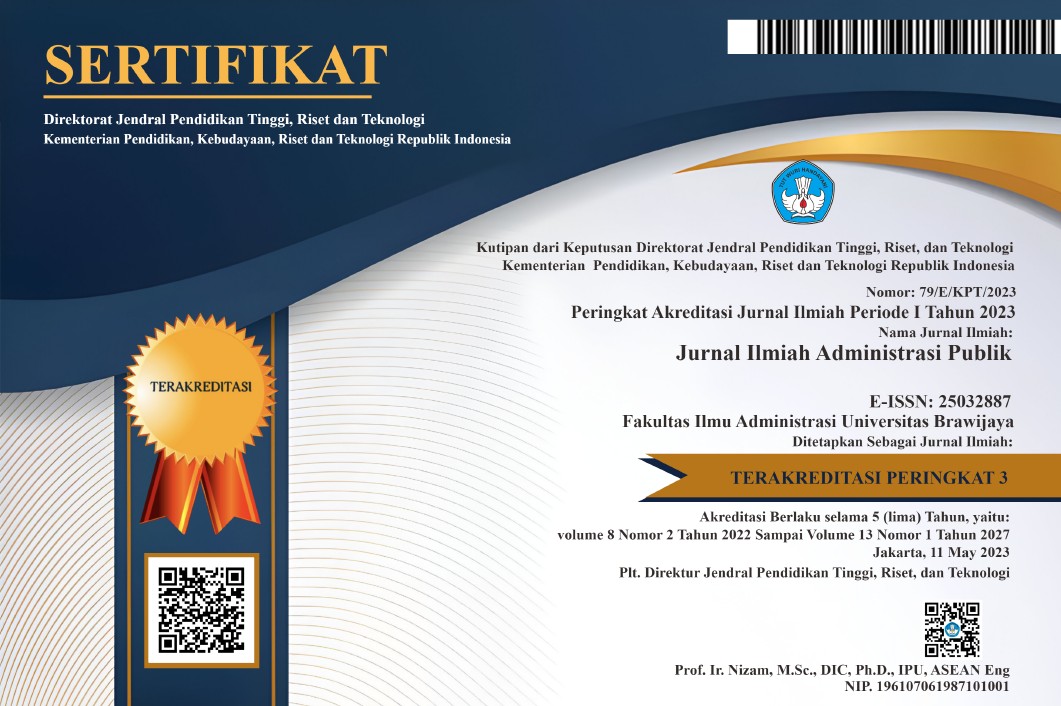Critical Success Factors (CSFs) of Balanced Scorecard Implementation in Public Sector Institution (A Study in the Ministry of Foreign Affairs (MoFA) Indonesia)
DOI:
https://doi.org/10.21776/ub.jiap.2020.006.01.14Keywords:
balanced scorecard implementation, critical success factors, public sectorAbstract
Implementing Balanced Scorecard (BSC) in public sector’s performance management system is interesting, due to public sector’s concern for performance measurement. As one promising performance management tools, BSC was originally designed for the private sector institution, but later gaining its popularity among the public institutions. How well BSC implementation is possibly determined by some Critical Success Factors (CSFs). This study examined some CSFs in the BSC implementation in the Ministry of Foreign Affairs (MoFA) Indonesia using a qualitative study with an interactive model by Miles at al., (2014). This study found that BSC implementation brought changes in the MoFA’s performance, despite the absence of organizational changes for BSC adaptation. Top and middle management attention for the implementation and training and education are the most determining factors in the BSC implementation in MoFA. This study support the importance of the four CSFs examined in this study in implementing BSC in public sector.References
Arnaboldi, M., Lapsley, I., & Steccolini, I. (2015). Performance management in the public sector: The ultimate challenge. Financial Accountability & Management, Vol. 31, No. 1, pp.1–22. https://doi.org/10.1111/faam.12049
Buchanan, D., Fitzgerald, L., Ketley, D., Gollop, R., Jones, J. L., Saint Lamont, S., … Whitby, E. (2005). “Not going backâ€: A review of the literature on sustainable organisational change. International Journal of Management Reviews, Vol. 7, No. 3, pp.189–205. https://doi.org/10.1111/j.1468-2370.2005.00111.x
Budiarso, A., & Mir, M. (2012). The Role of Leadership in Sustainable Public Sector Performance Outcome. ACRN Journal Entrepreneurship Perspectives, Vol. 1, No. 2, pp. 1–23.
Chan, Yeeâ€Ching Lilian. (2004). Performance measurement and adoption of balanced scorecards: A survey of municipal governments in the USA and Canada. International Journal of Public Sector Management, Vol. 17, Issue. 3, pp.204-221, https://doi.org/10.1108/09513550410530144
Dimitropoulos, P., Kosmas, I., & Douvis, I. (2017). Implementing the balanced scorecard in a local government sport organization Evidence from Greece. International Journal of Productivity and Performance Management, Vol. 66, No. 3, pp.362–379. https://doi.org/10.1108/IJPPM-11-2015-0167
Greiling, D. (2010). Balanced scorecard implementation in German nonâ€profit organisations. International Journal of Productivity and Performance Management, Vol. 59, No. 6, pp.534-554. https://doi.org/10.1108/17410401011063939
Hood, C. (1995). The “new public management†in the 1980s: Variations on a theme. Accounting, Organizations and Society. Vol. 20, No. 2–3, pp.93–109. https://doi.org/10.1016/0361-3682(93)E0001-W
Hoque, Z. (2014). 20 years of studies on the balanced scorecard: Trends, accomplishments, gaps and opportunities for future research. British Accounting Review, Vol. 46, No.1, pp.33–59. https://doi.org/10.1016/j.bar.2013.10.003
Jääskeläinen, A., & Sillanpää, V. (2013). Overcoming challenges in the implementation of performance measurement. International Journal of Public Sector Management, Vol. 26, No. 6, pp.440–454. https://doi.org/10.1108/IJPSM-12-2011-0014
Kaplan, R. S., & Norton, D. P. (1996). Strategic learning & the Balanced scorecard. Strategy & Leadership Leadership, Vol. 24, No. 5, pp.18–24.
Lueg, R., & Vu, L. (2015). Success Factors in Balanced Scorecard Implementations – a Literature Review. Management Revu, Vol. 26, No.4, pp.306–327. https://doi.org/10.1688/mrev-2015-04-Lueg
McAdam, R., Hazlett, S., & Casey, C. (2005). Performance management in the UK public sector. International Journal of Public Sector Management, Vol. 18, No. 3, pp.256–273. https://doi.org/10.1108/09513550510591542
Miles, Matthew B., Huberman, A. Michael., & Saldaña, J. (2014). Qualitative Data Analysis A Method Sourcebook (3rd ed.). California: SAGE Publication Inc.
MoFA. (2015). Laporan Kinerja Kementerian Luar Negeri Tahun 2015: Buku II Informasi Kinerja. Available at https://kemlu.go.id/portal/id/read/223/akip/laporan-kinerja-kemenlu [Accessed on 20 March 2019].
MoFA, (2019). Dashboard Kinerja. Website. Available at https://e-kinerja.kemlu.go.id/ [Accessed on 5 July 2019].
Moullin, M. (2017). Improving and evaluating performance with the Public Sector Scorecard. International Journal of Productivity and Performance Management, Vol. 66, No. 4, pp.442–458. https://doi.org/10.1108/IJPPM-06-2015-0092
Niven, P. R. (2002). Balanced Scorecard Step-By-Step For Government and Nonprofit Agencies. New York: John Wiley & Sons, Inc.
Niven, P. R. (2008). Balanced Scorecard Step-By-Step for Government and Nonprofit Agencies (2nd ed.). New Jersey: John Wiley & Sons, Inc.
Northcott, D., & Ma’amora Taulapapa, T. (2012). Using the balanced scorecard to manage performance in public sector organizations. International Journal of Public Sector Management, Vol. 25, No. 3, pp.166–191. https://doi.org/10.1108/09513551211224234
Perkins, M., Grey, A., & Remmers, H. (2014). What do we really mean by “Balanced Scorecard�. International Journal of Productivity and Performance Management, Vol. 63, No. 2, pp.148–169. https://doi.org/10.1108/IJPPM-11-2012-0127
Pollitt, C., & Bouckaert, G. (2011). Public management reform: a comparative analysis (New public management, governance, and the neo-weberian state (3rd Edition)). Oxford: Oxford University Press.
Speklé, R. F., & Verbeeten, F. H. M. (2014). The use of performance measurement systems in the public sector: Effects on performance. Management Accounting Research, Vol. 25, No. 2, pp.131–146. https://doi.org/10.1016/j.mar.2013.07.004
Yeung, Allen Kwokwah., & Connel, Julia. (2006). The Application of Niven’s Balanced Scorecard in a non-For-Profit Organization in Hongkong: What Are the Factors for Success?. Journal of Asia Business Studies, Vol. 1, No. 1, pp. 26–33. https://doi.org/10.1108/15587890680001302
Downloads
Published
Issue
Section
License
If your paper is accepted, the author identified as the formal corresponding author for the paper will receive an email prompting them to login into Author Services; where via the JIAP Author Licensing Service they will be able to complete the license agreement on behalf of all authors on the paper.














